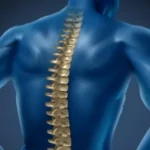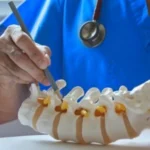Why Discomfort in the Lower Back Becomes More Frequent with Age
Back pain in middle aged females presents unique challenges often related to hormonal changes, decreased bone density, and lifestyle factors. Women between 40-60 years frequently experience back pain due to:
- Hormonal Fluctuations: Estrogen decline during perimenopause and menopause affects bone density and can lead to vertebral compression or microfractures.
- Degenerative Disc Disease: Aging causes discs to lose cushioning and elasticity.
- Spinal stenosis: Narrowed spinal canal presses nerves, causing pain and weakness.
- Osteoporosis: Reduced bone density increases fracture risk, particularly in the spine.
- Spondylolisthesis: Vertebra slips forward, often due to aging.
Studies show that back pain in middle aged females can significantly impact quality of life, affecting sleep, mobility, and daily functioning. Many women in Delhi NCR juggle professional responsibilities with household management, creating additional physical strain that exacerbates back problems.

Early treatment is vital since chronic back pain can cause mental health issues. Lifestyle changes and non-surgical methods come first, but surgery may be needed if they fail.
Understanding Endoscopic Spine Surgery: A Modern Approach
Endoscopic spine surgery is a minimally invasive technique using small 7-10 mm incisions and a high-def camera.
The precision of endoscopic spine surgery allows for targeted treatment with minimal tissue disruption. Unlike open surgery, endoscopic spine surgery gently separates muscles, reducing tissue damage.
The procedure employs a precise methodology where surgeons:
- Make small incisions (8-10 mm)
- Insert specialized endoscopic equipment
- Utilize real-time visualization through the endoscope
- Perform necessary repairs or decompressions with specialized instruments
- Close the small incisions, often with just a stitch or two
This technique effectively treats various spinal conditions, including:
- Herniated or slipped discs
- Spinal stenosis
- Degenerative disc disease
- Sciatica
- Cervical spondylosis
- Vertebral compression fractures
The endoscopic approach allows surgeons to directly visualize the problem area while magnifying the surgical field, enabling precise removal of problematic tissue without damaging healthy structures. This targeted approach is one of the key reasons why endoscopic spine surgery offers significant advantages over traditional methods.
Top Endoscopic Spine Surgery Benefits You Should Know
The endoscopic spine surgery benefits extend far beyond the operating room, impacting everything from the immediate surgical experience to long-term outcomes. Here are the key advantages that make this approach increasingly popular:
Reduced Tissue Trauma
- Minimal muscle disruption as muscles are separated rather than cut
- Significantly less blood loss compared to open procedures
- Lower infection risk due to smaller incisions and reduced exposure
- Preservation of spinal stability and normal anatomy
Improved Recovery Metrics
- Higher recovery rates (approximately 84% compared to 60-80% in traditional surgery)
- Significant cost savings due to shorter hospital stays
- Reduced need for post-operative pain medication
- Faster return to daily activities and work
Enhanced Surgical Precision
- Magnified visualization allows for more accurate treatment
- Better targeted access to spinal pathology
- Reduced risk of damage to surrounding healthy tissues
- Ability to address complex spinal issues through minimally invasive means
Patient Experience Improvements
- Less post-operative pain due to reduced tissue damage
- Minimal scarring with incisions often less than 1 cm
- Same-day discharge for many procedures
- Reduced risk of complications like muscle weakness or spinal instability
Long-term endoscopic spine surgery benefits often include better preservation of spinal mobility and function, as the procedure maintains the structural integrity of the spine while addressing the specific problem area. This targeted approach often results in more sustainable pain relief and improved quality of life.
Choosing the Right Expert for Your Endoscopic Spine Surgery
When searching for the best endoscopic spine surgeon in Delhi, consider factors like experience, success rates, and patient reviews. The complexity of spine surgery demands specialized expertise, particularly for minimally invasive techniques that require advanced training and significant experience.
Key factors that distinguish a leading spine specialist include:
- Specialized Training: Advanced fellowship training in minimally invasive and endoscopic spine techniques
- Surgical Volume: Regular performance of endoscopic procedures, maintaining skill and expertise
- Technological Proficiency: Mastery of the latest endoscopic equipment and techniques
- Comprehensive Approach: Ability to offer both surgical and non-surgical treatment options
- Patient Outcomes: Documented success rates and patient satisfaction metrics
Patients seeking the best endoscopic spine surgeon in Delhi often choose Sant Paramanand Hospital for its advanced facilities, which include state-of-the-art endoscopic equipment, specialized operating rooms, and comprehensive rehabilitation services.
The right surgeon will take time to thoroughly evaluate your condition, explain all treatment options, and develop a personalized care plan. This patient-centered approach is essential for achieving optimal outcomes in spine care.
Choosing a Back Pain Specialist: What You Should Know
The best doctor for back pain in Delhi offers comprehensive diagnosis and treatment. Consider these key factors when choosing one:
Diagnostic Expertise
Thorough diagnosis is key; top specialists use advanced methods:
- Comprehensive physical examinations
- Advanced imaging (MRI, CT scans, X-rays)
- Electromyography (EMG) when nerve involvement is suspected
- Detailed patient history analysis
Treatment Philosophy
The best doctor for back pain in Delhi typically follows a stepped approach:
- Conservative treatments first (physical therapy, medications, injections)
- Minimally invasive procedures when conservative approaches fail
- Traditional surgery only when absolutely necessary
Multidisciplinary Approach
Back pain often requires a team approach. Leading specialists collaborate with:
- Physical therapists
- Pain management specialists
- Rehabilitation experts
- Nutritionists and lifestyle counselors
Patient Education Focus
Exceptional doctors prioritize patient education, helping you understand:
- The specific cause of your back pain
- Treatment options with risks and benefits.
- Lifestyle modifications to support spine health
- Preventive strategies to avoid recurrence
Patient testimonials can help identify the best doctor for back pain in Delhi for your specific condition. Look for consistent positive feedback regarding pain relief, improved function, and quality of patient communication.
How to Identify the Right Doctor for Slip Disc Treatment
The best doctor for slip disc in Delhi will typically offer both surgical and non-surgical treatment options. Herniated or “slipped” discs represent one of the most common spinal conditions requiring specialized care, particularly when they cause nerve compression and radiating pain.
When evaluating the best doctor for slip disc in Delhi, look for specialists in minimally invasive techniques. The expertise required for successful slip disc treatment includes:
Specialized Knowledge
- Understanding of disc pathology and nerve compression mechanics
- Ability to interpret subtle findings on imaging studies
- Knowledge of when surgery is necessary versus when conservative treatment will suffice
Technical Skill
- Precision in targeting the exact location of disc herniation
- Ability to decompress nerves without causing instability
- Expertise in preserving spinal function while addressing pathology
Comprehensive Care
- Customized treatment plans based on individual factors
- Integration of physical therapy and rehabilitation
- Long-term strategies for spine health maintenance
Consulting the best doctor for slip disc in Delhi early can prevent further complications and chronic pain. Early intervention often leads to better outcomes, as prolonged nerve compression can cause permanent damage and more difficult-to-treat chronic pain syndromes.
Sant Paramanand Hospital uses endoscopic techniques for precise, minimally invasive slip disc treatment. This targeted approach often results in immediate relief of nerve compression symptoms while preserving the structural integrity of the spine.
The Endoscopic Spine Surgery Procedure: What to Expect
Knowing about endoscopic spine surgery helps ease anxiety and prepare patients. The procedure typically follows these steps:
Pre-Operative Preparation
- Anesthesia: local with sedation or general, depending on the procedure and patient.
- Positioning: Patient placed for best access, comfort, and safety.
- Imaging Guidance: Advanced fluoroscopic (real-time X-ray) guidance helps determine the precise entry point for the endoscope.
Surgical Procedure
- Incision: A small incision (7-10 mm) is made at the predetermined entry point.
- Dilation: Gentle tissue dilation creates a working channel to the spine without cutting through muscles.
- Endoscope Insertion: The endoscope with its attached camera is inserted, providing high-definition visualization of the surgical area.
- Treatment: Specialized instruments are used through the endoscope to address the specific problem:
- For herniated discs: Removal of herniated material
- For spinal stenosis: Decompression of nerve structures
- For bone spurs: Careful removal of problematic bone
- Verification: The surgeon confirms adequate decompression or repair before removing the instruments.
- Closure: The small incision is closed, often requiring just a stitch or two and a small bandage.
The procedure generally lasts 1-2 hours, varying with complexity. Many patients are surprised by how quickly the surgery is completed compared to traditional open procedures.
Endoscopic spine surgery causes less blood loss, lower infection risk, and less pain than traditional methods.
What to Expect: Endoscopic Spine Surgery Recovery Time Explained
The typical endoscopic spine surgery recovery time ranges from 1-4 weeks for most patients, a dramatic improvement over the months often required after traditional open spine surgery. This accelerated recovery is one of the most significant advantages of the endoscopic approach.
Immediate Post-Operative Period (1-3 Days)
- Same-day discharge for many patients
- Early mobility encouraged, often walking the same day as surgery
- Pain management typically requires only mild analgesics
- Basic self-care activities usually possible within 24 hours
Early Recovery Phase (1-2 Weeks)
- Gradual return to normal daily activities
- Minimal activity restrictions compared to traditional surgery
- Follow-up visit to check incision healing
- Beginning of gentle rehabilitation exercises
Full Recovery Phase (2-6 Weeks)
- Return to work, typically within 1-4 weeks depending on job demands
- Progressive increase in physical activities
- Continued improvement in strength and flexibility
- Resolution of surgical site discomfort
Factors that influence endoscopic spine surgery recovery time include age, overall health, and the specific procedure performed. Patients with sedentary jobs often return to work sooner than those with physically demanding occupations.
Many patients are surprised by the shortened endoscopic spine surgery recovery time compared to traditional approaches. This rapid recovery is possible because endoscopic techniques preserve muscle function and spinal stability while addressing the underlying problem.
Post-operative care instructions typically include:
- Wound care guidelines
- Activity recommendations
- Pain management strategies
- Warning signs that require medical attention
- Schedule for follow-up appointments
Advanced Minimally Invasive Back Pain Treatment Options
Modern minimally invasive back pain treatment options have revolutionized spine care in recent years. Beyond endoscopic surgery, several innovative approaches offer alternatives to traditional open procedures:
Endoscopic Discectomy
This procedure specifically targets herniated discs, using an endoscope to remove disc material that is pressing on nerves. The approach allows for:
- Precise removal of only the problematic portion of the disc
- Preservation of disc height and function
- Immediate relief of nerve compression symptoms
Percutaneous Laser Disc Decompression
For certain disc herniations, laser energy can be used to:
- Reduce pressure within the disc
- Shrink the herniation
- Decompress affected nerves
- Provide relief with minimal tissue disruption
Endoscopic Foraminotomy
When nerve exit channels (foramina) are narrowed, this procedure can:
- Enlarge the foramen
- Free compressed nerve roots
- Alleviate radiating pain
- Improve neurological function
Endoscopic Facet Rhizotomy
For facet joint pain, this technique uses radiofrequency energy to:
- Target specific pain-transmitting nerves
- Provide long-lasting pain relief
- Avoid disruption of spinal stability
- Offer a same-day, outpatient solution
Doctors now recommend minimally invasive back pain treatment before considering open surgical approaches. This paradigm shift reflects growing evidence that less invasive techniques often provide equivalent or superior outcomes with fewer risks and complications.
The goal of minimally invasive back pain treatment is to provide relief while preserving normal anatomy and function. This focus on tissue preservation helps maintain spinal stability and mobility, leading to better long-term outcomes for patients.
Conclusion: Taking the First Step Toward Back Pain Relief
Living with chronic back pain significantly impacts quality of life, but advanced treatment options like endoscopic spine surgery offer new hope for those who haven’t found relief through conservative measures. The minimally invasive nature of these procedures provides numerous benefits, including reduced tissue trauma, faster recovery, and excellent outcomes.
When searching for the best endoscopic spine surgeon in Delhi, consider the expertise available at Sant Paramanand Hospital. The specialized care provided by Dr. Amit Shridhar combines technical excellence with a compassionate, patient-centered approach.
If back pain persists despite treatments, consult about endoscopic surgery. Early action improves outcomes and prevents chronic pain.
Take the first step toward reclaiming your active, pain-free life by exploring the advanced spine care options available right here in Delhi NCR. With the right specialist and treatment approach, relief from chronic back pain is within reach.



